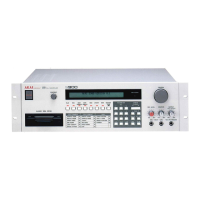10
PART 3: THE
TUNE
BUTTON
FUNCTIONS
TUNE FUNCTIONS
To adjust the S900 tuning to that of other
instruments:
1
.
Press the MASTER
TUNE function button.
2. Enter the desired
detuning
as
+ or
—
followed by a
two digit
number between
00 and
16. Negative numbers
offset tuning
lower,
positive
numbers offset tuning
higher. Numbers
greater
than 1
6
are not recognized.
3. To exit MASTER TUNE
mode, hit any
other function button.
PART 4: THE MIDI
BUTTON
FUNCTIONS
MIDI FUNCTIONS
A MIDI
controller
sends
out
MIDI
data that
describes your
perfor-
mance— which notes
are being played, dynamics,
modulation,
etc.
The
S900 receives this data (if
all is set
properly) and pro-
duces
sounds
according to
the
data
it
receives.
MIDI
CHANNEL AND
MODEPAGE 01
SELECT^
MIDI transmitters send data out over
a
particular channel
from 1
to
16 (this is usually selectable). A MIDI receiver (such as
the
S900)
has two main modes of
operation:
•
OMNI ON (the
S900
receives
any MIDI data
that
appears
on
any channel) . This mode is useful for having the
S900
receive
master controller data without having
to
think
about
channel
selection.
•
OMNI OFF
(the S900 receives any MIDI data that appears
on
one channel). In most situations,
turn OMNI off and set the
S900
to the same channel number
as the transmitter (see
below).
MIDI CHANNEL SELECT
1
.
Point arrow at "Basic MIDI channel."
2. Enter a two-digit channel number with the
0—9
keys.
Enter
leading zeroes (i.e.
01
, not
1
).
OMNI ON/OFF
(MODE)
SELECT
1. Point arrow
at "Omni on/off."
2. Press
+ key
for OMNI ON and
-
for
OMNI OFF.
3. If the channels have been properly
selected, playing the
master controller will cause the
MIDI RECEIVE light to glow.
I
PAGE
02
1
MIDI TEST SIGNAL
TRANSMIT
^CTfMNEL, NOTE, VELOCITY, TRIGGER)
This page lets
you
trigger
a
note in
the
S900
via the Play parame-
ter button (not the PLAY function
button).
Pushing
the
Play
parameter button also sends MIDI
note and velocity data out the
MIDI Out connector.
This
feature is useful for triggering
a
note
without having to
use
an
external
controller
(e.g. MIDI
keyboard).
CHANNEL SELECT
Point arrow at "Channel"
and enter the two-digit channel
number
(i.e.
01 , 02
... 1
6)
over which the MIDI
test signal will
appear.
NOTE: This
must be
the same
number as
the
S900 basic MID!
channel (selected
on Page 1
)
if
you want to
trigger
the
S900.
NOTE
SELECT
Point
arrow at
"Key"
and use
the
0—9
keys or
CONTROL to
enter the
desired
MIDI note
number (middle C=60h
VELOCITY
SELECT
Point arrow at
"Velocity"
and use
the
0-9
keys
or
CONTROL to
enter
the desired
velocity
(loudness).
TRIGGER
NOTE
Press the
Play
parameter
button (not
the
PLAY
function
button)
at any time
to
send the
MIDI data
through MIDI Out
and also trig-
ger
the specified note
within the
S900.
IPAGEQ3I
INCOMING MIDI
SIGNAL
ANALYZER
Page
03 is
your
"window on
MIDI" and shows:
®
The channel over
which
the Master
Controller is sending
notes.
•
The last note
played by
the Master
controller, both in
musical
terminology and
MIDI
note
number.
®
The velocity
(dynamics)
of the last
note played (displayed
for
as
long as
the note
is held
down)
.
There are no
user-settable
parameters on
this page. It is used
solely as a
monitor. If
the
S900
is
not responding
properly
to
the
master controller, use
this function to
verify the channel number
and also, that the
master
controller is
sending
out
valid note and
velocity data.
PAGE
04I
PITCH
WHEEL
RESPONSE
This
page
lets
you
trim the S900's
response to the MIDI Master
Controller's
pitch wheel.
1
.
Point arrow at "Pitch
wheel range
(
±
semitones)."
2. Select the range of
the
pitch bend
travel, from
:±1
semitone
to
±1
2 semitones, by
entering a
two-digit number
(01 ,
02
.
.
.
1
2)
or turning the
CONTROL.
PAGE
05 RS-232
PORT
PARAMETERS
The
S900
may be
controlled
from
the RS-232 port included
on
many home computers as
well as
via
MIDI (for more
information,
refer to the Appendix "RS-232
Applications").
In RS-232
mode,
the
S900 Baud
Rate
(speed of
communications)
must
match
that
of
the computer.
MIDI/RS-232
SELECT
Point arrow at "Control
by
MIDI
(1)
RS232 (2).
or 2
for RS-232.
Enter
1 for MIDI
RS-232 BAUD
RATE
SELECT
Point arrow at "RS232
Baud
rate."
The Baud
rate
is
a
five-digit
number; enter the first
four
digits
of the
number.
Example:
For
1 9200
Baud rate, enter
1
-9-2-0.
For 300 Baud rate, enter
0-0-3-0.
For
9600
Baud rate, enter
0-9-6-0.
You can
also use
the
CONTROL but
this
is
not recommended
as
it takes
more
time
to
make
adjustments.
The
LCD
will show a
measurement
of the
actual
Baud rate. If It
is
more than ±2%
different
from
the intended Baud rate, there
is
a
problem.

